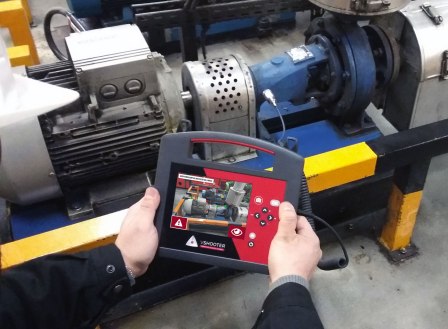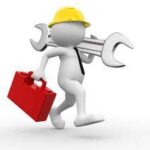The reliability of many objects, machines, transport means, various appliances, or processes can be increased and operational costs can be reduced by the application of diagnostics. This is a branch of technology dealing with the methods and means for ascertaining the condition of investigated objects. Even the “reliability” of humans can be increased and the life can be prolonged in some cases if the health condition is diagnosed (e.g. by cancer screening of people achieving a certain age or by measuring specific body parameters of patients in hospitals). In this chapter, only the basic diagnostic terms will be explained briefly, with an emphasis on technical objects. However, the applicability is much more general.
The main tasks of technical diagnostics are as follows:
1. Determination of the technical condition of the diagnosed object: (a) now (current condition), (b) in the past, and (c) in the future.
2. After a failure: determination of the place, extent, and cause of the failure (detection, localization, and identification of the failure).
3. If the technical condition of the object is good: prediction of its future development (Figs. 5 and 7 in Chapter 6), determination of the further duration of operation, and determination of the time for the next inspection or maintenance.
The technical condition of an object is the condition characterizing its ability to fulfill the demanded functions (under assumed conditions). It can be described by diagnostic quantities.
The diagnostic quantity (or parameter) is a quantity that carries information on technical condition and can be used for diagnostics. Various quantities can serve for diagnosing. The basic kinds of diagnostic quantities are as follows:
1. Time of use
It is the total (calendar) time of operation and breaks. This quantity yields certain information on the corrosion or aging but not about wear. For example, if one wants to buy a second-hand car, the first information, which is looked at, is its age.
Operating time
a. The time necessary for doing some work (the time for which the construction was loaded or working; also the number of loading cycles). This quantity, however, does not sufficiently reflect the variable operating regime and loads. This makes no problem for objects with monotonic conditions of operation.
b. The amount of the performed work (driven distance, amount of consumed fuel, area of the harvested field, number of machined pieces, product of the mileage, weight of cargo transported by a truck, etc.). The buyer of a second-hand car is also interested in the total mileage the car has driven.
Structural parameters
Parameters that directly characterize the technical condition or extent of damage of individual components (wear of the cylinders in an engine or of other components; e.g. tires, size of cracks, magnitude of deformations, the clearance between the shaft and bearing, the value of electrical resistance, decrease of thickness of load-carrying parts due to corrosion or wear, and amount and condition of the lubricating oil). These quantities have very high informative value. A drawback is that they often can be determined only on a disassembled object.
Operational parameters
They are derived from structural parameters and express the properties of the diagnosed object or illustrate its changed technical condition. Examples are vibrations, temperatures, fuel consumption, noise, and efficiency. They characterize the technical condition directly and can be monitored without disassembling. As such, they are sometimes measured by the user, but sometimes during special tests when the structure is exposed to specific loads (e.g. load tests of a bridge). A drawback is that operational parameters can be measured only on objects able of operation.
The changes of technical condition lead to the changes of some components of operational costs (e.g. those for fuel consumption). Therefore, the following quantities are sometimes monitored: total cumulative costs C(t), average unit costs C1(t) = C(t)/t, and instantaneous unit costs dC1(t)/dt. They can be used for the determination of the cost-based optimum instant for renewal, as it will be described in Chapter 17. The advantage, as well as disadvantage, of cost indicators is that they depend not only on the technical condition of the object, but also on the current level of prices.
Application of technical diagnostics
Diagnostics can be carried out in several ways. The simplest is manual diagnostics, either visual or with the use of universal devices (e.g. observation of the tires of a car, inspection of the condition of a certain object, such as a building, bridge, or dam; measurement of deformations, either permanent or under certain load, strain gauge measurement of stresses, measurement of vibrations or noise). Semiautomatic diagnostics needs special devices, but it works according to a fixed regime, which can also be controlled by a technician. Automatic diagnostics is performed by a special system, where a computer controls the testing of all important parameters and functions. The system can work in an adaptive manner: it selects (and stores) only the important quantities to be measured, with respect to the course and results of the ongoing diagnostic process. Diagnostic systems can be on-board or station-type. Stationary systems are used for various objects and are either stable (immovable) or mobile. Stable systems are used in service stations for technical control (e.g. analysis of exhaust gases or adjustment of lights in cars). A mobile system is installed in a vehicle (e.g. in a van, a special wagon or another transportable appliance for measurements on railways). For example, aircrafts, locomotives or cars have today often installed sensors for the demanded quantities. Then, a measuring vehicle comes and its devices are connected with them via the plugs. On-board diagnostic systems are installed in the diagnosed object and measure during its usual operation (e.g. the amount of fuel or temperature of bearings). Often they are only oriented at certain parameters (e.g. dynamic response of a wagon bogie during a ride).
Advantages of diagnostics
1. Diagnostics enables quick finding of the place and cause of a failure and thus the reduction of the time necessary for the repair.
2. The regular monitoring of technical condition makes possible the prevention of serious failures as well as the prevention of the fast degradation of properties or worsening the economy of operation by finding the optimum time for the maintenance and renewal.
3. Diagnostics enables the planning of more serious repairs and reconstructions in advance, so that they can be done in the most suitable time, with minimum time losses and unfavorable consequences for the operation, production, or traffic.
Drawbacks of diagnostics
The use of diagnostics increases the total costs. Diagnostics is useful, but not for any costs. One generally aims at the minimum sum of the costs for diagnostics and the losses caused by insufficient diagnosing, and a compromise is often necessary. More about diagnostics can be found in the literature, for example [1, 2]. Some books deal with diagnostics from the point of view of data and information processing; others are devoted to the instruments for diagnostics or to the application of diagnostics in special branches, such as machines, electrical appliances or electricity supply, and vehicles, and to the use of diagnostics in medicine.


